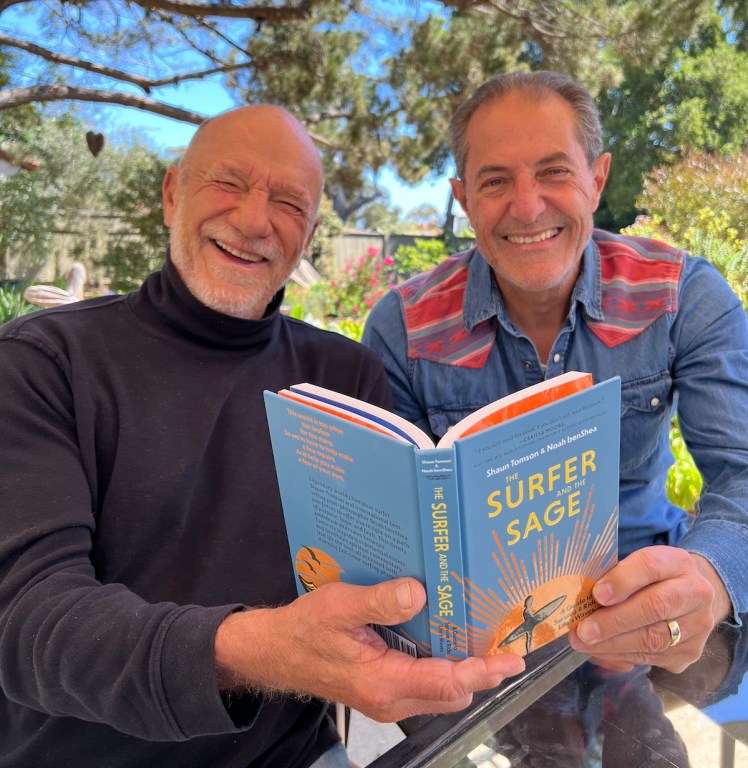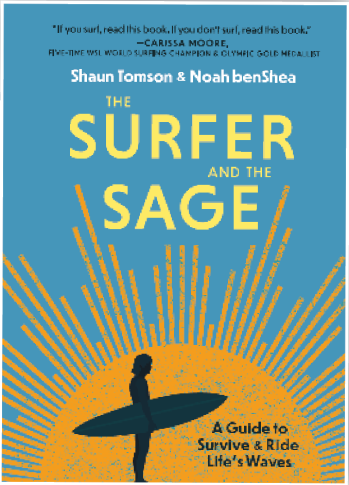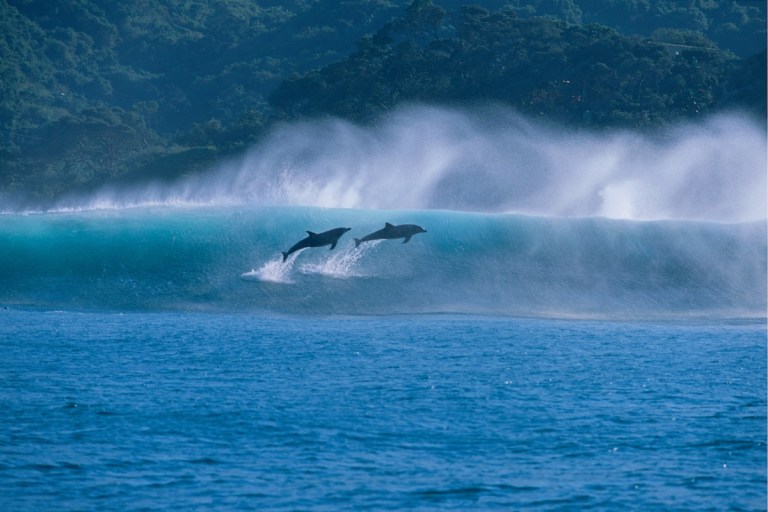Santa Barbara’s Surfer and Sage
Wave-Riding Champ Shaun Tomson and Philosopher-Poet Noah benShea Pen Pandemic Pick-Me-Up Book
By Keith Hamm | June 2, 2022

Emerging from the lingering pandemic, an upbeat new book — and first-time collaboration — by Shaun Tomson and Noah benShea hits coffee tables and nightstands this month. While Tomson and benShea share little by way of upbringing — Tomson grew up surfing in South Africa as benShea followed scholarly paths from his native Canada — their mutual interest in bettering the often-bleak outlooks of the audiences they speak to brought them together as coronavirus uncertainties spread worldwide.
Published by family-focused Familius, The Surfer and the Sage: A Guide to Survive & Ride Life’s Waves is a compact self-help collection of insights, poems, and vignettes that take on 18 life dualities chaptered across 196 pages — from “Despair and Hope” to “Isolated and Connected” to “Fear and Courage,” with dozens of color photographs by Santa Barbara–based Dan Merkel. For the chapter themes, “We put the negative before the positive so people can see that there’s a path — moving from despair to hope, for example,” explains Tomson. “It’s about finding your footing, keeping your balance.”

For Tomson, who started surfing competitively at 12 and captured the 1977 world title a decade later, the book advances his work as a pro surfer turned motivational speaker. But more importantly, it’s the ongoing effort of a grieving father using his reach and experience to help people, especially teens, make better decisions. In 2006, Tomson’s son Mathew, 15 at the time, died while playing a “choking game” that restricts oxygen to the brain, according to news reports. In The Surfer and the Sage, Tomson describes regaining his faith after that terrible loss. This is his third book.
Best-selling author of more than two dozen books, benShea’s Jacob the Baker series is his most widely known and translated. He graduated with a bachelor’s degree in English from UCLA in 1967 and in 1974 earned an advanced degree in poetry from Goddard College in Vermont. In the early 1990s, his syndicated “Noah’s Window” column was nominated for the Pulitzer Prize. Over the decades, he has also worked as a professor, translator, resident philosopher, lecturer, and speaker.
To young people struggling with mental illness, he reminds them that they’re not in this alone. “Don’t confuse how you feel with who you are,” he says. “Know that you’re somebody special. Know that somebody wanted you to know about this [perspective] — that’s why we’re putting this out there.”
Ahead of their book launch, the Independent caught up with Tomson and benShea to get more background on the project and deeper insight on some of its themes.
Talk about the seed of this project.

Noah benShea: Shaun and I spoke at the same TEDx in Paris, where I gave the keynote. We didn’t meet at the time, but Shaun spoke profoundly and his remarks were sent my way. We met for lunch early in 2020 [in Santa Barbara]. Both of us felt it was like meeting an old friend for the first time, and we wanted the excuse of more time together and doing something that shared our mutual life agenda to make a difference in the lives of others. Shaun suggested the book’s title. I suggested its subtitle. Honoring that, we both began typing.
Shaun Tomson: We simply liked each other immediately. Noah said, “Let’s write a book together.” I said, “Yes!” And we were away on that ride together.
What helped you decide he’d make a good writing partner?
NB: In life, more often than not, we know what doesn’t fit. But when the right fit comes into play — wow! And scripture says that two should travel together so if one should falter the other would be there. Shaun and I lift each other so our work might lift others.
ST: I think at heart we have a great love for helping people be better. Both of us have separately been in the positive-inspiration world for decades.
How did the pandemic influence your writing?
NB: During the pandemic, as many lost their balance and many others were tragically lost forever, I was even more self-reminding that things don’t have to be going good for people for them to be great. Falling is not failing. For the child in all of us, falling is a preamble to learning to stand, a preamble to walking, and a promise that one day you will run to the best in you.
ST: Through the pandemic, I did virtual presentations to schools, universities, sports teams, a drug rehab clinic, a group of PTSD survivors, and some of the world’s largest corporations. At the beginning of each livestream, I would ask people to send me a word that described how they were feeling. The four most common words were “stress,” “anxiety,” “depression,” and “disconnection.” I called it a SADD mindset. The book had a strong mission to try to help change that mindset as it settled over the world.
The book’s themes aren’t lost on young adults, teens, or even kids. What’s the best way to connect to that audience?
NB: Keep it simple. Don’t talk down to anyone because they are younger, and always try to lift whomever you are speaking with or writing for. At the same time, I know I am no longer young enough to know everything. The old are wise, and the young will lead them.
ST: I talk to tens of thousands of young people across the globe — at poor schools and posh schools. I tell simple and emotional stories about character that are genuine and authentic. To reach youth, you better tell it straight from the heart.
Part of the book’s message is about making better choices. Often, the better choice is clear and accessible, yet many of us choose otherwise. Why?
NB: Neurophysiology reminds us that the information we take in from the time we are children runs like rivers making alleyways in our brain. All future information wants to run down those alleyways. The choices we make in our lives tend toward what is familiar and perhaps negative. You have to stop and think: Does this way of thinking serve me or enslave me?
ST: Our choices define us. Professor Ralph Keeney at Duke University released an interesting paper saying that poor choices lead to a million preventable deaths each year in the U.S. alone. It’s a calamity hiding in plain sight. In the book, we try to show the duality of life and offer perspectives and perhaps ways to make transitions from darkness to light.
I specifically encourage people to create their own “Code” for positive decision-making: Write 12 lines, each beginning with “I will….” Complete the exercise in 15 minutes. This simple method can help allay the feeling of being swept along powerlessly — a way to find the internal power to make the right choices.

How did your faith inform this book? Some people are receptive to religious doctrine. Others are not. Was there a balancing act?
NB: While faith is a bedrock in religions, faith is not singularly a religious doctrine. Faith is the courage to see what is unseen. And faith’s first requirement is to have faith in yourself. If you cannot trust yourself, you will not trust others. If you cannot be honest with yourself, you will not be honest with others.
Faith is commonly at play — when we drive through the green light at an intersection, we have faith we will not get hit. Will someone ever run a red light? Yes. But regardless of your religious faith or lack thereof, you are inclined to believe — to have faith — that you will arrive home safely.
ST: We wanted an interdenominational book that anyone of any religion could pick up and perhaps glean some hope, truth, and faith from our perspective.
While this is not a religious book, it is a deeply spiritual book. I agree with Noah that faith is a bedrock of religion. What we have faith in is what we stand on and is seldom revealed — but we believe anyway.
My bedrock of belief was fractured when I lost my son. It was like an earthquake broke my faith. In the book, I write how a single bolt of lightning, out of a clear blue sky, miraculously restored that foundation.
At this point in your life, what are you hoping to share with the next generation?
NB: The act of reaching out with kindness is transforming. A “small act of kindness” is a contradiction in terms. Kindness is not bordered by size. All kindness expands infinitely — the smallest stone dropped in the widest sea will send radiating circles to shores you will never know.
ST: With age and joy and pain comes a measure of wisdom and knowledge. This little book is a perspective, not a prescription; a guide, not an instruction manual. Our time here is limited, so you better make it count. Love your family and friends and stay connected to them. Find a physical pursuit that gets you out in nature and gets your heart beating. Volunteer and make a difference to something or someone. Get involved in a project or work that inspires you and uplifts others too. If needed, reconnect with your faith, whatever that might be. And know that no matter how dark the night may seem during those despairing hours, the sun will rise again.
Anything you’d like to emphasize or add?
NB: The most common shared password in life these days is “anxiety.” Knowing this about each other is our shared brotherhood and sisterhood. Shaun and I are two souls a little further down the trail than some, and we hope to be guides of caring and insight to all.
ST: At every keynote, I ask the audience to write their Code — those 12 lines, each beginning with “I will….” This is a way to find and define purpose. From students at humble schools in Africa and Asia to CEOs and their teams at the world’s hottest corporations, I have read thousands of lines of Code over the last 16 years since I started this process at Anacapa School [in Santa Barbara]. Everyone writes the same two lines: “I will be better” and “I will help others be better.” We hope this book helps with being better.
The Surfer and the Sage Events
Tecolote Book Shop (1470 East Valley Rd., Montecito): In-person book launch and signing, Sat., June 4, 3 p.m.
Patagonia (235 W. Santa Clara St., Ventura): In-person book signing, Thu., June 9, 6:30 p.m.
Santa Barbara Maritime Museum (113 Harbor Wy.): In-person lecture, discussion, and book-signing, plus a presentation of surf photographs, Thu., June 16, 7 p.m. Registration required: sbmm.org/santa-barbara-event.
Montecito Country Mart (1016 Coast Village Rd., Montecito): In-person book signing, Wed., June 22, 5 p.m.




You must be logged in to post a comment.